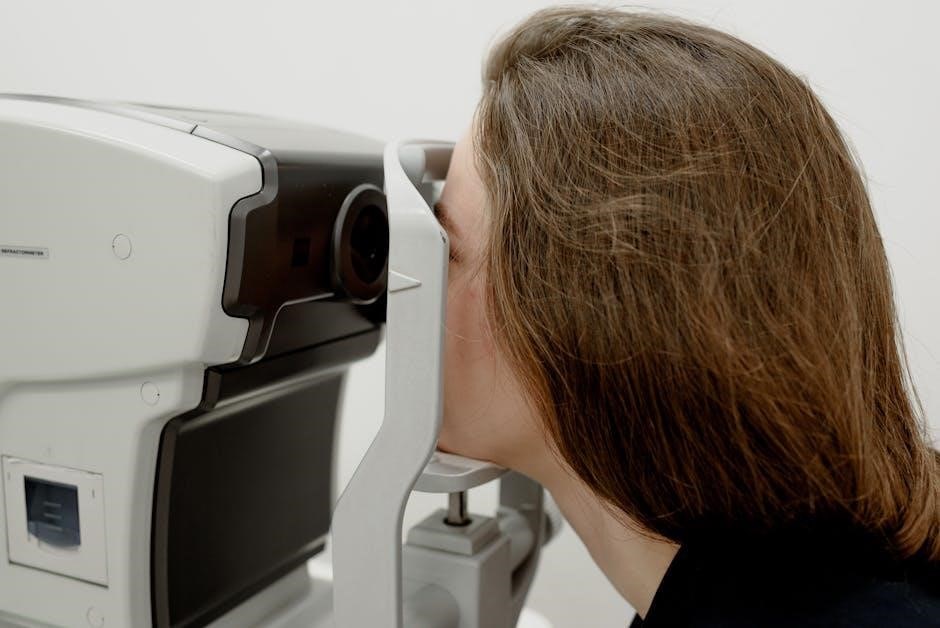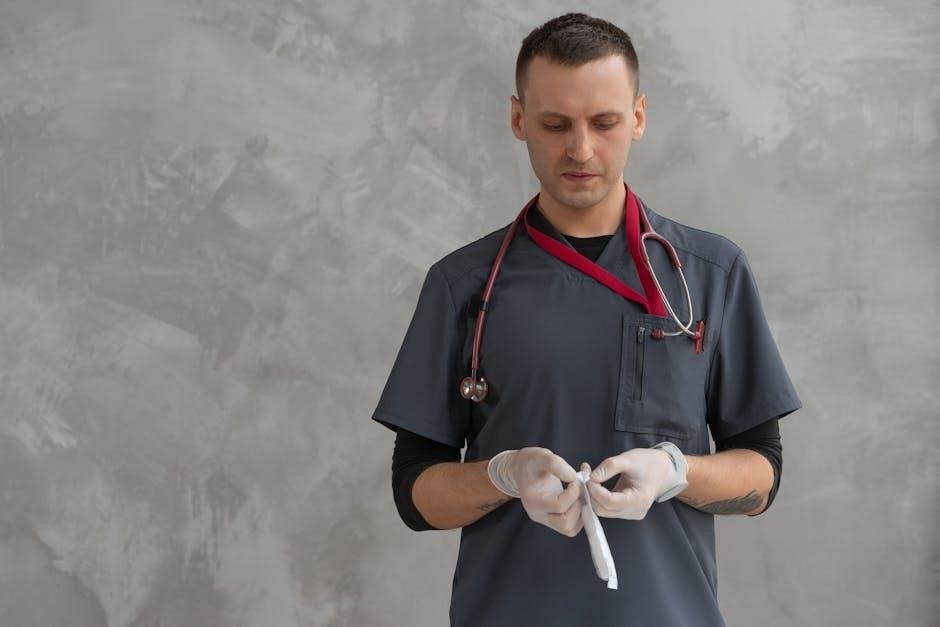
wastewater treatment exam questions and answers pdf
Wastewater treatment is crucial for environmental health and public safety. Exams and certifications ensure operators are qualified. Resources like PDF guides and practice questions are essential for preparation.
1.1 Definition and Importance of Wastewater Treatment
Wastewater treatment refers to processes that remove contaminants from water discharged from domestic‚ industrial‚ or agricultural activities. It is essential for protecting aquatic ecosystems‚ ensuring public health‚ and preventing environmental pollution. Effective treatment plants handle various types of wastewater‚ including sanitary‚ industrial‚ and stormwater runoff. Proper treatment ensures the water released back into the environment is safe‚ reducing risks of disease and ecological damage. Certification exams for operators emphasize this importance‚ requiring deep knowledge of treatment processes and regulations to maintain high standards of water quality and environmental protection.
1.2 Overview of Wastewater Treatment Processes
Wastewater treatment involves a series of physical‚ chemical‚ and biological processes to remove pollutants. Primary treatment includes screening and sedimentation to eliminate solids. Secondary treatment uses biological methods like activated sludge or trickling filters to break down organic matter. Tertiary treatment‚ such as filtration or disinfection‚ further purifies water for reuse. Sludge management is also critical‚ with processes like anaerobic digestion and dewatering to handle residuals. These stages ensure water quality meets environmental standards‚ making treated water safe for discharge or reuse in agriculture and industry.
1.3 Role of Exams in Wastewater Treatment Certification
Exams are essential for validating expertise in wastewater treatment‚ ensuring operators meet industry standards. They assess knowledge of processes‚ regulations‚ and problem-solving skills. Certification exams often include multiple-choice questions‚ case studies‚ and mathematical calculations. Resources like PDF guides and practice exams help candidates prepare effectively. These assessments verify understanding of treatment technologies and compliance with environmental laws. Passing exams is critical for career advancement and maintaining safe‚ efficient plant operations. They also ensure professionals stay updated on evolving regulations and advancements in wastewater management.
Key Concepts in Wastewater Treatment
Understanding treatment methods‚ water quality‚ and pollutant removal is fundamental; Processes include physical‚ chemical‚ and biological techniques to eliminate contaminants. Exam questions often focus on these concepts‚ ensuring operators grasp essential principles for effective wastewater management and environmental compliance.
2.1 Physical‚ Chemical‚ and Biological Treatment Methods
Physical methods‚ such as filtration and sedimentation‚ remove suspended solids. Chemical treatments use coagulants or disinfectants to neutralize pollutants. Biological processes‚ like activated sludge‚ rely on microbes to break down organic matter. These methods are often combined for effective wastewater purification. Exam questions frequently test understanding of these processes‚ including their applications and efficiencies. Mastering these concepts is crucial for operators to ensure compliance with environmental standards and maintain treatment plant performance. Resources like PDF guides provide detailed explanations and practice problems to aid in exam preparation.
2.2 Wastewater Characteristics and Pollutant Removal
Wastewater characteristics include biological oxygen demand (BOD)‚ chemical oxygen demand (COD)‚ total suspended solids (TSS)‚ pH‚ and temperature. Effective treatment requires understanding these parameters. Pollutant removal involves physical‚ chemical‚ and biological methods tailored to specific contaminants. BOD and COD reductions are critical for assessing treatment efficiency. Exam questions often focus on calculating removal efficiency and matching treatment methods to pollutant types. Resources like PDF guides provide detailed case studies and practice problems to help operators master these concepts‚ ensuring compliance with environmental standards and optimal treatment performance.
2.3 Sludge Management and Disposal Techniques
Sludge management is a critical component of wastewater treatment‚ involving thickening‚ digestion‚ and dewatering to reduce volume and pathogens. Disposal methods include land application‚ incineration‚ and landfilling. Exam questions often cover sludge processing calculations and regulatory compliance. Resources like PDF guides provide detailed case studies and practice problems‚ ensuring operators understand proper handling and environmental impact. Effective sludge management minimizes waste and protects public health‚ making it a key focus in certification exams and real-world applications.

Common Exam Questions on Wastewater Treatment
Exams often include multiple-choice‚ true/false‚ and fill-in-the-blank questions on processes like BOD removal and sludge management. Resources like PDF guides offer practice exams and answers for preparation.
3.1 Multiple Choice Questions on Wastewater Processes
Multiple-choice questions on wastewater processes test knowledge of treatment methods‚ BOD removal‚ and sludge management. Examples include calculating flow rates or identifying treatment stages. Resources like PDF guides provide practice exams with answers‚ ensuring readiness for certification. These questions assess understanding of both theoretical concepts and practical applications‚ such as disinfection methods or pollutant removal efficiency. Familiarity with math problems‚ like dosage calculations‚ is also essential for success in these exams.
3.2 True/False and Fill-in-the-Blank Questions
True/false and fill-in-the-blank questions assess knowledge retention and understanding of key concepts in wastewater treatment. These questions often focus on definitions‚ processes‚ and regulations. For example‚ identifying whether combined sewers mix stormwater and sewage or filling in the correct term for a treatment stage. Resources like PDF study guides offer practice sets‚ helping candidates master these formats. They also cover mathematical aspects‚ such as calculating BOD removal efficiency or chemical dosages‚ ensuring comprehensive exam preparation.
3.3 Case Studies and Problem-Solving Scenarios
Case studies and problem-solving scenarios in wastewater treatment exams test practical application of knowledge. Examples include calculating BOD removal efficiency or managing oilfield wastewater spills. These questions simulate real-world challenges‚ such as handling combined sewer overflows or optimizing treatment processes; Candidates must analyze data‚ identify solutions‚ and apply regulations. Resources like PDF guides provide practice scenarios‚ ensuring operators can address environmental and operational issues effectively. These exercises are critical for developing the skills needed to troubleshoot and manage wastewater treatment plants efficiently.

Wastewater Treatment Math and Calculations
Mastering math skills is essential for wastewater treatment operators. Key calculations include flow rates‚ BOD removal efficiency‚ and chemical dosages. Practice with PDF guides ensures accuracy.
4.1 Flow Rate and Volume Calculations
Flow rate and volume calculations are critical in wastewater treatment to determine plant capacity and efficiency. Common formulas include Q = A * v for flow rate and V = Q * t for volume over time. Understanding units like MGD (million gallons per day) and GPA (gallons per acre) is essential. Practice questions often involve calculating flow in pipes or treatment volumes. Accurate calculations ensure compliance with regulations and proper system operation. Study guides and PDF resources provide examples and exercises to master these concepts for certification exams.
4.2 BOD‚ COD‚ and TSS Removal Efficiency
BOD (Biochemical Oxygen Demand)‚ COD (Chemical Oxygen Demand)‚ and TSS (Total Suspended Solids) are key parameters in wastewater treatment. BOD measures organic matter decomposition‚ COD assesses chemical contaminants‚ and TSS evaluates suspended solids. Removal efficiency is calculated using influent and effluent values. Exams often include questions on improving efficiency and meeting regulatory standards. Practice questions and PDF guides provide examples for mastering these calculations‚ ensuring operators understand how to optimize treatment processes and maintain environmental compliance.
4.3 Dosage Calculations for Chemical Treatment
Dosage calculations are critical in chemical wastewater treatment to ensure effective contaminant removal. Parameters like flow rate‚ concentration‚ and contact time are essential. For example‚ chlorine dosage for disinfection is calculated based on effluent requirements. Practice questions in PDF guides often include scenarios like determining pounds of chlorine needed per million gallons. These calculations are frequently tested in exams‚ emphasizing the importance of accurate math skills. Resources and practice exams help operators master these computations‚ ensuring compliance with treatment standards and environmental regulations.

Biological Wastewater Treatment Processes
Biological processes‚ like activated sludge and anaerobic treatment‚ are key in breaking down organic matter. Exam questions often focus on nutrient removal and microbial activity in these systems.
5;1 Activated Sludge Process and Its Variations
The activated sludge process is a widely used biological treatment method where microorganisms break down organic matter in wastewater. Variations include conventional‚ extended aeration‚ and sequencing batch reactors. Exam questions often focus on process optimization‚ sludge age‚ and BOD removal efficiency. Understanding aeration‚ settling‚ and return sludge rates is critical. Common questions also cover troubleshooting issues like bulking sludge. Study guides highlight the importance of microbial activity and nutrient removal in these systems. Ensuring proper process control is vital for achieving effluent quality standards and regulatory compliance.
5.2 Trickling Filters and Rotating Biological Contactors
Trickling filters and rotating biological contactors (RBCs) are fixed-film biological treatment methods. Trickling filters use a stationary media where microorganisms form a biofilm‚ breaking down wastewater as it trickles through. RBCs employ rotating disks submerged in wastewater‚ allowing biofilms to grow and treat organic matter. Exam questions often focus on hydraulic loading rates‚ media types‚ and process efficiency. Understanding the differences in operation‚ maintenance‚ and applications is key. Both systems are effective for secondary treatment‚ with RBCs offering higher efficiency in smaller footprints. Proper design and operation ensure optimal BOD and COD removal.
5.3 Anaerobic Treatment and Its Applications
Anaerobic treatment is a biological process that breaks down organic matter without oxygen‚ producing biogas (methane and carbon dioxide). It is highly effective for treating high-strength wastewaters‚ such as from food processing or industrial sources. Anaerobic systems‚ like anaerobic digesters‚ are commonly used for sludge stabilization. Exam questions often cover design parameters‚ such as hydraulic retention time and temperature requirements. Applications include energy recovery through biogas utilization and nutrient removal. Proper operation and maintenance are critical for optimal performance and methane production.

Chemical and Physical Wastewater Treatment
Chemical and physical methods remove contaminants through processes like coagulation‚ sedimentation‚ and filtration. Exams often include questions on disinfection methods and chemical dosing calculations for efficient treatment.
6.1 Coagulation‚ Sedimentation‚ and Filtration
Coagulation‚ sedimentation‚ and filtration are critical physical-chemical processes in wastewater treatment. Exams often include questions on dosage calculations for coagulants like alum or ferric chloride. Common topics include understanding the role of sedimentation basins in removing suspended solids and the effectiveness of filtration systems in polishing treated water. Multiple-choice questions may test knowledge of optimal pH ranges for coagulation or the impact of hydraulic loading rates on filter performance. Practical problem-solving scenarios‚ such as calculating the required dose of a coagulant to achieve desired turbidity levels‚ are also frequently included in certification exams.
6.2 Disinfection Methods (UV‚ Chlorine‚ Ozone)
Disinfection methods like UV‚ chlorine‚ and ozone are essential for eliminating pathogens in wastewater. Exams often include questions comparing these technologies‚ such as UV’s non-toxic nature versus chlorine’s residual effects. Calculations for chlorine dosage and ozone demand are common. True/false questions might test knowledge of ozone’s oxidizing power or UV’s reliance on water clarity. Case studies may involve selecting the best disinfection method based on effluent quality goals or addressing challenges like byproduct formation. Understanding these methods’ advantages and limitations is critical for certification success.
6.3 Advanced Oxidation Processes (AOPs)
Advanced Oxidation Processes (AOPs) are powerful methods for removing recalcitrant pollutants in wastewater. Common AOPs include ozone (O3)‚ hydrogen peroxide (H2O2)‚ and titanium dioxide (TiO2). Exams often test knowledge of AOP mechanisms‚ such as hydroxyl radical generation. Questions may ask for comparisons of AOPs with traditional disinfection methods or their effectiveness against specific contaminants. True/false questions might focus on byproduct formation risks. Case studies may involve calculating oxidant dosages or selecting the best AOP for emerging pollutants like pharmaceuticals. Understanding AOP advantages and limitations is vital for exam success.
Wastewater Collection and Conveyance
Wastewater collection involves sewer systems and pumping stations. Pipeline hydraulics ensure efficient flow. Proper management prevents environmental contamination and ensures public health.
7.1 Sewer Systems and Pumping Stations
Sewer systems collect and transport wastewater to treatment plants. Combined sewers mix stormwater and sewage‚ requiring careful management during heavy rainfall. Pumping stations ensure wastewater flows uphill‚ maintaining proper conveyance. Exam questions often focus on hydraulic calculations‚ system design‚ and operational challenges. Understanding flow rates and pipeline efficiency is critical for effective sewer management. Proper maintenance prevents overflows and environmental contamination. These systems are vital for protecting public health and water quality‚ making them a key area of focus in wastewater treatment exams.
7.2 Combined Sewers and Stormwater Management
Combined sewers collect both stormwater and domestic sewage in a single system. During heavy rainfall‚ the increased flow can overwhelm the system‚ leading to combined sewer overflows (CSOs). Managing these systems requires strategies to mitigate overflows and protect water quality. Exam questions often focus on the components of combined sewers‚ their operational challenges‚ and stormwater management techniques. Understanding these systems is crucial for maintaining environmental health and ensuring regulatory compliance. Effective management prevents pollution and safeguards aquatic ecosystems‚ making it a critical area of study for wastewater treatment professionals.
7.4 Pipeline Hydraulics and Flow Calculations
Pipeline hydraulics and flow calculations are essential for designing and operating wastewater collection systems. Key factors include pressure‚ velocity‚ and friction loss. The Hazen-Williams equation is commonly used to determine flow rates in gravity sewers. Accurate calculations ensure proper system design‚ preventing overflow and maintaining efficiency. Exam questions often test understanding of these principles‚ including Reynolds number and Manning’s formula. Mastery of these concepts is critical for wastewater engineers to ensure reliable and sustainable sewer systems‚ adhering to environmental and safety standards.

Wastewater Treatment Plant Operations
Wastewater treatment plant operations involve pre-treatment‚ primary‚ and secondary processes to remove pollutants. Monitoring and troubleshooting ensure efficiency and safety‚ addressing issues like overflow and equipment malfunctions effectively.
8.1 Pre-Treatment and Primary Treatment Processes
Pre-treatment involves removing large debris and grit to protect equipment‚ while primary treatment uses sedimentation to separate solids and liquids. These initial steps ensure efficient organic matter removal. Exam questions often focus on processes like screening and sedimentation‚ with resources providing insights into flow dynamics and component functionality. Understanding these processes is vital for plant operations‚ as they prevent equipment damage and optimize subsequent treatment stages. Study guides and practice exams offer detailed explanations and scenarios to help prepare for certification tests effectively.
8.2 Secondary and Tertiary Treatment Methods
Secondary treatment removes organic matter via biological processes like activated sludge or trickling filters. Tertiary treatment includes advanced methods such as filtration‚ disinfection‚ or chemical treatment to meet stringent water quality standards. Exam questions often focus on process efficiency‚ troubleshooting‚ and compliance with regulations. Resources like PDF guides and practice exams provide insights into BOD‚ COD‚ and TSS removal calculations‚ ensuring operators understand how to optimize these processes effectively. These stages are critical for producing reusable water and protecting aquatic ecosystems.
8.3 Monitoring and Troubleshooting Plant Operations
Monitoring wastewater treatment operations ensures efficiency and compliance with regulations. Operators must track parameters like pH‚ flow rates‚ and BOD levels. Troubleshooting involves identifying issues such as sludge bulking or poor sedimentation. Exam questions often cover these topics‚ requiring practical solutions. Resources like PDF guides and practice exams provide case studies and scenarios to test problem-solving skills. Understanding these processes is vital for maintaining optimal plant performance and passing certification exams.

Wastewater Treatment Exam Preparation Resources
Utilize PDF guides and practice exams to prepare effectively. Resources include study manuals‚ online practice questions‚ and case studies. These tools enhance knowledge and problem-solving skills.
9.1 Recommended Study Guides and Manuals
For effective exam preparation‚ utilize study guides and manuals like the Wastewater Treatment Exam Questions and Answers PDF‚ which offers 100 correct answers. These resources provide detailed insights into wastewater processes‚ math calculations‚ and regulatory compliance. They include practice questions‚ case studies‚ and problem-solving scenarios. Manuals such as the Wastewater Treatment Plant Operator Study Guide outline key concepts and exam strategies. Printable materials and online resources like the Wastewater Operators Guide to Certification are also available‚ ensuring comprehensive preparation for certification exams. These tools are essential for mastering both theoretical and practical aspects of wastewater treatment.
9.2 Online Practice Exams and PDF Materials
Online platforms offer extensive resources for exam preparation‚ including practice exams and downloadable PDF materials. Websites like Docsity provide Wastewater Treatment Exam Questions and Answers with 100 correct responses. YouTube channels and forums share free practice questions‚ while printable guides cover topics like math calculations and regulatory compliance. These resources include multiple-choice questions‚ case studies‚ and problem-solving scenarios. Additionally‚ PDF compilations such as the Wastewater Engineering Q Compilation are available‚ offering answers to common exam questions. These tools enhance preparation by simulating real exam conditions and improving time management skills.
9.3 Tips for Success in Certification Exams
Success in wastewater treatment certification exams requires strategic preparation. Start by thoroughly understanding basic concepts and math calculations. Utilize PDF study guides and online resources like Docsity for practice questions. Focus on solving case studies and problem-solving scenarios to improve analytical skills. Allocate time for each question type during practice to enhance time management. Review exam formats‚ such as multiple-choice and true/false questions‚ to familiarize yourself with the structure. Additionally‚ stay updated on environmental regulations and treatment technologies‚ as these are frequently tested topics. Regularly review mistakes to refine your knowledge and approach.

Case Studies and Real-World Applications
Real-world case studies provide practical insights into wastewater treatment challenges and solutions. Examples include large-scale treatment plants and innovative technologies addressing specific pollution issues effectively.
10.1 Examples of Wastewater Treatment Plants
Real-world examples of wastewater treatment plants highlight their critical role in environmental protection. Plants like the Rockaway facility showcase advanced pre-treatment processes‚ including grit removal. These plants handle millions of gallons daily‚ ensuring pollutants are effectively removed. Case studies reveal how facilities manage challenges like combined sewers and stormwater overflow. Innovative technologies‚ such as anaerobic treatment‚ are applied to optimize efficiency. These examples demonstrate practical solutions to wastewater management‚ emphasizing sustainability and compliance with environmental regulations.
10.2 Challenges and Solutions in Wastewater Management
Wastewater management faces challenges like increasing industrial contaminants and aging infrastructure. Solutions include adopting advanced technologies such as AOPs for pollutant removal and improving monitoring systems for real-time issue detection. Effective operator training and certification programs are crucial for maintaining efficiency and compliance with regulations.
10.3 Innovations in Wastewater Treatment Technologies
Advancements in wastewater treatment include technologies like advanced oxidation processes (AOPs) and membrane bioreactors (MBRs)‚ which enhance pollutant removal efficiency. Ultraviolet (UV) disinfection and biological treatments‚ such as anaerobic digestion‚ are also being optimized. Innovations in sludge management‚ like thermal hydrolysis‚ improve resource recovery. These technologies address emerging contaminants and increase sustainability‚ making wastewater treatment more effective and environmentally friendly while meeting stringent regulatory standards.

Exam Questions on Wastewater Regulations
Exam questions often cover environmental laws‚ permit requirements‚ and reporting standards. Understanding compliance measures and regulatory impacts on treatment processes is critical for certification success.
11.1 Environmental Laws and Compliance
Environmental laws‚ such as the Clean Water Act‚ regulate wastewater discharge to protect water quality. Compliance ensures treatment plants meet effluent standards. Key aspects include permit requirements‚ monitoring‚ and reporting. Understanding these laws is critical for certification exams‚ as they often feature questions on regulatory frameworks. For example‚ questions may ask about National Pollutant Discharge Elimination System (NPDES) permits or the Safe Drinking Water Act. Staying updated on legal changes and their operational impacts is essential for wastewater professionals to maintain compliance and avoid penalties.
11.2 Permitting and Reporting Requirements
Permitting and reporting are essential for ensuring wastewater treatment plants operate within legal standards. Facilities must obtain permits‚ such as the NPDES permit‚ to discharge treated effluent. Reporting requirements include submitting data on flow rates‚ pollutant levels‚ and compliance status. Exam questions often focus on understanding permit conditions‚ sampling frequencies‚ and documentation processes. For instance‚ questions may ask about the frequency of reporting under the Clean Water Act or the parameters monitored in discharge reports. Accurate record-keeping is critical to avoid non-compliance issues and potential penalties.
- Permits regulate effluent discharge into water bodies.
- Reporting ensures transparency and accountability.
- Non-compliance can result in fines or operational changes.
11.3 Impact of Regulations on Treatment Processes
Regulations significantly influence wastewater treatment processes by setting strict discharge standards and requiring advanced technologies. Compliance with environmental laws ensures safer effluent release‚ protecting aquatic ecosystems. For example‚ the Clean Water Act mandates specific pollutant removal levels‚ driving the adoption of methods like filtration and chemical treatment. Non-compliance can lead to fines or operational changes. Exam questions often test knowledge of regulatory impacts on process modifications and monitoring practices. Understanding these dynamics is crucial for effective plant operation and certification success.
- Regulations enforce stricter discharge standards.
- Advanced technologies are often mandated.
- Non-compliance results in penalties.

Wastewater Treatment Exam Strategies
Effective exam strategies include practicing with sample questions‚ studying guides‚ and understanding common question types. Time management and avoiding mistakes are crucial for success.
12.1 Time Management During the Exam
Effective time management is critical for success in wastewater treatment exams. Allocate time evenly across question types‚ ensuring ample minutes for complex case studies. Start with questions you find easier to build confidence and rhythm. Use techniques like the Pomodoro method to maintain focus. Avoid spending too long on a single question—flag it and return later. Prioritize questions based on point value and difficulty. Practice mock exams to improve speed and accuracy. Remember‚ proper time allocation ensures you attempt all questions‚ maximizing your potential score.
12.2 Approaches to Different Question Types
Mastering wastewater treatment exams requires tailored strategies for each question type. For multiple-choice questions‚ identify key terms and eliminate incorrect options. True/False questions demand precise understanding of concepts. Fill-in-the-blank questions test familiarity with formulas and definitions. Case studies and problem-solving scenarios require systematic analysis‚ breaking down problems into manageable parts. Practice identifying common exam patterns and focus on high-weight questions. Utilize answer sheets effectively‚ ensuring clarity in responses. Regularly review exam formats and question types to build confidence and precision. This targeted approach enhances problem-solving skills and exam performance.
12.3 Common Mistakes to Avoid
Common mistakes in wastewater treatment exams include rushing through questions‚ misinterpreting question types‚ and neglecting to review answers. Calculation errors are frequent‚ especially in flow rate and BOD problems. Candidates often overlook units conversion or misapply formulas. Time management is critical; allocate equal time to each section. Avoid guessing without analyzing options‚ as incorrect answers may penalize scores. Familiarize yourself with exam formats and practice under timed conditions. Reviewing past papers helps identify recurring errors and improves accuracy. Stay calm and systematic to minimize mistakes and maximize scores.